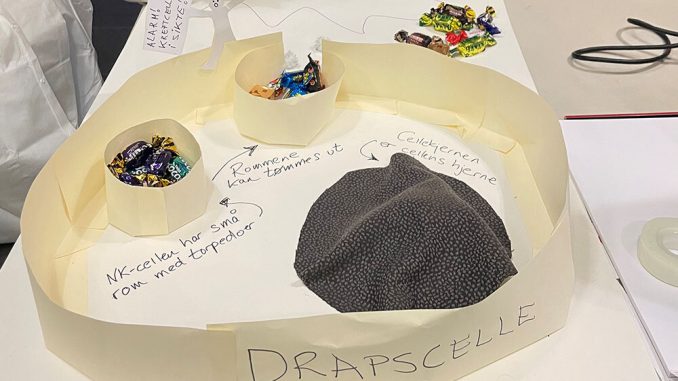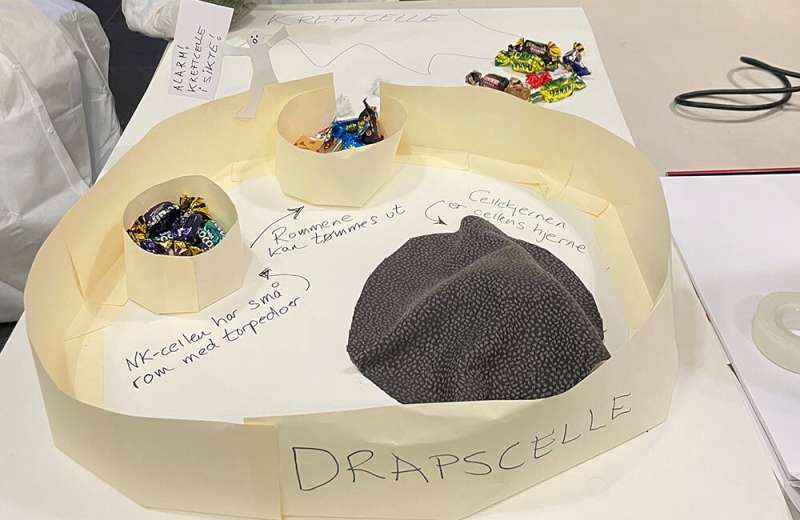

In our body, we have both an innate immune system and an immune system that is developed throughout life. Part of the innate immune system consists of so-called NK cells. This is a type of immune cell that specializes in killing cancer cells. These cells may be of great importance for cancer treatment in the future.
The NK cells kill cancer cells with the help of small “killer torpedoes” that the NK cells secrete. In biology, they are called vesicles. Vesicles are small bubbles with a fatty wall of lipids and a space filled with toxic proteins. These are the torpedoes’ “weapons.”
Researchers at the Institute of Clinical Medicine have recently discovered new things about these killer torpedoes.
“We have discovered that we can separate the killer torpedoes from other types of vesicles so that they form a kind of arsenal of weapons. Our research also shows that this type of vesicle is probably stored in a separate room inside the NK cell,” Miriam Aarsund Larsen says.
She is a doctoral research fellow from the research group of Professor Marit Inngjerdingen at the Department of Pharmacology at the Institute of Clinical Medicine.
The goal is to develop a completely new type of immunotherapy against cancer—We intend to investigate this further. Our goal is to develop a new type of cancer treatment based on the killer vesicles in the NK cells, Aarsund Larsen says.
Marit Inngjerdingen and her research group are the only ones in Norway studying the vesicles in NK cells as a possible new type of treatment against cancer.
“Many people have heard of cell therapy, which is a form of immunotherapy where immune cells are used to fight cancer. But there are several challenges associated with this type of treatment. Among other things, the cancer cells prevent the body’s immune cells from attacking them,” Aarsund Larsen explains.
The killer torpedoes penetrate the cancer cells and kill them
The vesicles, which we here call killer torpedoes, have a built-in ability to attach themselves to cancer cells, and to penetrate and kill them.
“The killer torpedoes are good at getting into cancer tumors. They then use their weapons and skills to kill the cancer cells from the inside,” the doctoral research fellow explains.
This is a major advantage compared to other forms of cancer treatment, according to the researchers. They explain that another challenge with cell therapy is that the immune cells are not very good at getting into cancer tumors. Then it also becomes more difficult to attack them.
Inngjerdingen and Aarsund Larsen’s research shows that this is precisely what the killer torpedoes do so well.
“We can even imagine that we can fill them up with chemotherapy to provide more targeted treatment, with fewer side effects,” Aarsund Larsen says.
The research field is still in its early stages
The researchers emphasize that research on vesicles in NK cells as a possible new form of treatment against cancer is still in its early stages.
“This line of research has just begun, and we need to conduct many more studies before we can say with certainty that this is better than the therapy that is already on the market,” Aarsund Larsen says.
She points out that some studies have shown that vesicles have an effect in mice with cancer.
“Our plan is to manipulate our unique killer vesicles to become even better at attacking cancer tumors,” she explains.
Clinical studies on vesicles from stem cells
Clinical studies on vesicles from other types of cells already exist, especially on stem cells. These show that the vesicles have the ability to reduce corneal inflammation, according to the researchers.
“We believe that we can use vesicles from NK cells to kill various types of unwanted cells. This is not limited to cancer. It is also conceivable that we can direct them against over activated T cells, which are seen in various autoimmune conditions,” Inngjerdingen says.
Studying the killer torpedoes in NK cells in the lab
Inngjerdingen and Aarsund Larsen examined the killer vesicles in NK cells from humans that they cultured in the laboratory. They tested them on cancer cell lines, which are immortalized cancer cells from patients. They have used these to make small lumps of cancer, in order to be able to model a real tumor.
“Then we measured how many cancer cells died after treatment with the killer vesicles,” Aarsund Larsen says.
The findings are published in the journal Frontiers in Immunology.
More information:
Miriam Aarsund et al, Isolation of a cytolytic subpopulation of extracellular vesicles derived from NK cells containing NKG7 and cytolytic proteins, Frontiers in Immunology (2022). DOI: 10.3389/fimmu.2022.977353
Journal information:
Frontiers in Immunology
Source: Read Full Article